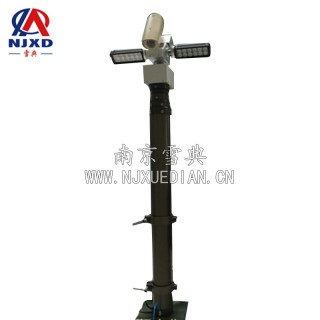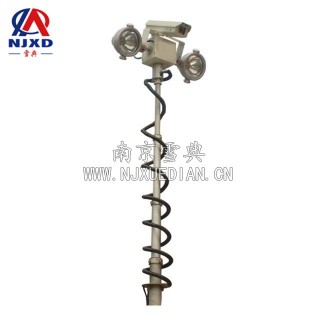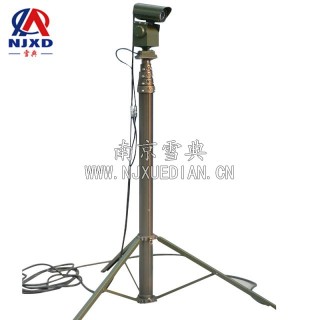NEWS
Load capacity and environmental indicators of up to surveillance cloud platform
Time:2021-01-28 View:

Load capacity
The maximum load of the pan-tilt is the maximum load capacity in the vertical direction. The distance between the center of gravity of the camera (including the shield) and the working face of the PTZ is 50mm. The center of gravity must pass through the center of rotation of the PTZ and be perpendicular to the working face of the PTZ. This center is the maximum load point of the PTZ, the bearing capacity of the pan-tilt is based on this point. If the load position is not properly installed, the center of gravity deviates from the center of rotation, increasing the load torque, the actual load capacity will be less than the design value of the maximum load. Therefore, the greater the vertical rotation angle of the pan-tilt, the greater the deviation of the center of gravity, and the smaller the corresponding bearing weight. The load capacity of the PTZ is the key to select the PTZ. If the load capacity of the PTZ is less than the actual load, the operation function will not only decrease, but also the motor and gear of the PTZ will be damaged due to long-term overload. The actual load capacity of the pan-tilt can vary from 3kg to 50kg. For the same series of pan-tilt products, the bearing capacity during side loading is greater than that of the top mounting, and the bearing capacity of the high-speed type is smaller than that of the ordinary type.
Environmental indicators
The requirements of indoor PTZ are not high, and the indicators of the usage environment of PTZ are mainly aimed at outdoor PTZ. This includes the IP protection level of environment temperature limit, humidity limit and dustproof and waterproof. Generally, the PTZ temperature range used in outdoor environment is-20 ℃ to +60 ℃. If it is used in lower temperature environment, A temperature-controlled heater can be installed inside the pan-tilt to make the lower temperature reach-40℃ or lower. The humidity index is generally 95% non-condensing. The IP level of dustproof and waterproof shall be above ip66. The level of IP protection reflects the sealing degree of equipment, which mainly refers to dust prevention and liquid intrusion. It is an international standard and conforms to the BS5490 standard in 1997 and the IECS529 standard in 1976. The first value after IP indicates the degree of solid seal protection, the second position indicates the degree of liquid protection, and the third position indicates the degree of mechanical impact protection. In addition, in actual use, appropriate materials and protective layers should be selected according to the environment. For example, iron shell is not suitable for use in humid and corrosive environments.

Special purpose
PTZ has a wide range of applications, and various special industries also have certain requirements for PTZ products. Due to the special use environment, PTZ products are required to have special protection performance to meet the on-site environment. Common ones are underwater, high temperature type, low temperature type, anti-corrosion type and explosion-proof type. Special PTZ has strict requirements on the materials used, protection levels, protection methods, etc., and must comply with the corresponding special industry standards. Among them, explosion-proof head is the most prominent.
Brief introduction of explosion-proof equipment
In many industrial sectors such as petroleum, chemical industry, coal and national defense, various flammable and explosive gases may often leak or spill out during the production, processing, transportation and storage processes, liquid and all kinds of dust and fiber. After this kind of substance is mixed with air, it may become a mixture with explosion danger. When the concentration of the mixture reaches the range of explosion concentration, once the fire source appears, it will cause serious accidents such as explosion and fire. At present, various types of explosion-proof electric device equipment such as flameproof, intrinsic safety, safety increasing, positive pressure, oil-filled, sand-filled, non-fire pattern and so on have been developed.
Examples of combustible gas, steam level and temperature groups are as follows. For other items not listed in the table, please refer to Appendix A of GB3836.1.
All explosion-proof equipment used in coal mines is class I equipment, and other explosion-proof equipment used in factories is Class II equipment. According to the maximum test safety gap or minimum ignition current score applicable to explosive gas mixture in Class II equipment, it is Level A, B and C. T1 T6 is the maximum allowable surface temperature of the equipment, T1-450 ℃, T2-300 ℃, T3-200 ℃, T4-135 ℃, T5-100 ℃, T6-85 ℃.
When dust may accumulate on the surface of class I equipment, the maximum surface temperature is 150 ℃; The maximum surface temperature allowed for Class II equipment is T4-135 ℃, T5-100 ℃, and T6-85 ℃.
For electrical equipment with voltage not exceeding 1.2V, current not exceeding 0.1A, energy not exceeding 20 microfocus or power not exceeding 25MW, after being approved by explosion-proof Inspection Department, it can be directly used in explosive gas environment of factories and underground coal mines.
Explosion-proof principle
The application principles of explosion-proof equipment generally include Gap type, contact prevention type, safety measures type and other explosion-proof principles such as using the lag characteristics of explosion to support advanced power failure. Among them, it is applicable to the gap explosion-proof principle of TV system and the explosion-proof principle of adopting safety measures.
1. Clearance explosion-proof principle
Electric spark and arc can ignite explosive mixture. The gap explosion-proof structure established by Germany is a more reliable method to prevent arc ignition and other surrounding explosive mixtures. It has a solid enough shell that can withstand the maximum explosion pressure generated by the internal explosive gas mixture to ensure that it is not deformed or damaged, and it has a certain structural gap to cool the injected combustion product to spontaneous ignition temperature lower than that of the external explosive mixture through a certain flange length. The structural clearance can be composed of plane joint surface or cylinder joint surface, and can also be composed of curved circuit, thread or barrier type. Besides that. Structures such as micropore, mesh cover, lamination, sand filling and so on also belong to the explosion-proof form of this principle.
2.The explosion-proof principle of safety measures
A series of safety measures are adopted on the equipment to prevent spark, arc or dangerous temperature from being generated to the maximum extent, or effective protection components are adopted to generate spark, arc or temperature cannot ignite explosive mixture to achieve explosion-proof purpose. Explosion-proof safety enhancement type, intrinsic safety type and other electrical equipment are manufactured by using this principle.
Signs of explosion-proof equipment
Flameproof explosion-proof equipment "d" and intrinsically safe equipment have "ia" and "ib". Clear permanent convex mark "Ex" should be set at the obvious point of equipment shell ". At the same time, nameplate should be set at the obvious part of the equipment shell and fixed reliably. There should be "Ex" Mark, explosion-proof type mark, and the explosion-proof type, category, grade, temperature group, etc. are marked in sequence; Explosion-proof certificate number; Date of production, product number, the product standard indicates the contents that must be specified, etc.
For example, d II BT3 indicates explosion-proof Class II Class B T3 temperature Group explosion-proof equipment.
Materials of explosion-proof equipment
The shell of flameproof explosion-proof equipment should be able to withstand 1.5 times the actual maximum internal explosion pressure, but not less than 3.5 × 105 Pa. For the equipment used in class I mining face, the shell must be made of steel plate or cast steel; For the equipment of class I non-mining face, the shell can be made of no less than HT25-47 gray cast iron; for Class I portable equipment and class II equipment, the shell can be made of light alloy with tensile strength not less than 117.6N/mm2(12kg /mm2) and magnesium content not more than 0.5% (weight ratio).
The shell material of essential equipment can be made of light alloy with magnesium content not more than 0.5% (weight ratio) or plastic with surface resistance not more than 1×109Ω.

CATEGORY
NEWS
- Rotation and control principle of lifting surveillance cloud platform
- Load capacity and environmental indicators of up to surveillance cloud platform
- Fault handling method of lifting surveillance cloud platform
- Selection and installation of lifting professional electrical platform
- Technical parameters of lifting vehicle head